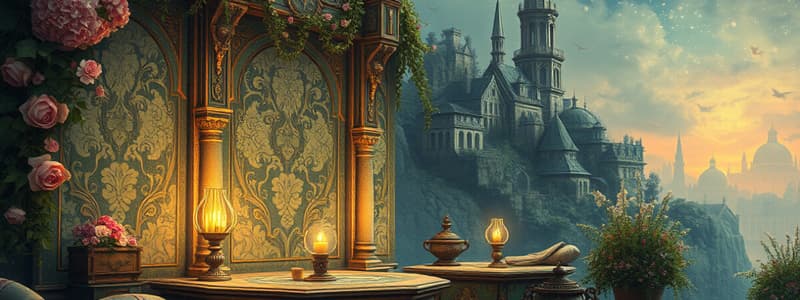Podcast
Questions and Answers
What is a line?
What is a line?
Element that is a path made by a moving point through space. It is one-dimensional and can vary in width, direction, and length.
What are the three properties of color?
What are the three properties of color?
Hue, intensity, and value.
What does texture refer to in art?
What does texture refer to in art?
Surface quality of an object, including actual and implied textures.
What does value refer to in the elements of art?
What does value refer to in the elements of art?
What is a shape in art?
What is a shape in art?
What is space in art?
What is space in art?
What is a form in art?
What is a form in art?
What does emphasis mean in art?
What does emphasis mean in art?
What does proportion refer to in art?
What does proportion refer to in art?
What is movement in art?
What is movement in art?
What does contrast refer to in art?
What does contrast refer to in art?
What is unity in art?
What is unity in art?
What is balance in art?
What is balance in art?
What does rhythm mean in art?
What does rhythm mean in art?
What is a pattern in art?
What is a pattern in art?
What are the elements of art?
What are the elements of art?
What is the principle of design?
What is the principle of design?
What is craftsmanship in art?
What is craftsmanship in art?
What is the subject in art?
What is the subject in art?
What is art media?
What is art media?
Who created The Scream?
Who created The Scream?
Explain the Elements and Principles of Design for the artwork Starry Night.
Explain the Elements and Principles of Design for the artwork Starry Night.
Flashcards are hidden until you start studying
Study Notes
Elements of Art
- Line: One-dimensional mark varying in width, direction, and length; represents a path made by a moving point.
- Color: Perceived through light reflection; characterized by hue (color name), intensity (strength), and value (lightness/darkness).
- Texture: Represents surface quality, can be actual (real feel) or implied (appearance of feel).
- Value: Refers to the lightness and darkness of a surface, essential in creating depth.
- Shape: Two-dimensional space defined by length and height; can be geometric (mathematical) or organic (natural).
- Space: Creates the illusion of depth; includes positive and negative spaces around and within objects.
- Form: Three-dimensional shape with length, width, and height; can be viewed from various angles and occupies physical space.
Principles of Design
- Emphasis: Establishes a focal point, guiding the viewer's attention to particular areas first.
- Proportion: Relates to the size and placement of elements in relation to each other and the whole artwork.
- Movement: Refers to the way the eye travels through the artwork, directing viewers from one part to another.
- Contrast: Highlights differences in elements, often using variations in value, size, and color to create visual interest.
- Unity: Achieved when all elements collectively form a balanced, harmonious whole; variety enhances interest.
- Balance: Distribution of visual weight; types include symmetrical, asymmetrical, and radial balance.
- Rhythm: Creates a visual beat through the repetition of elements or patterns, fostering interest and consistency.
- Pattern: Decorative repetition of elements such as shapes or colors to enhance visual appeal.
Additional Art Concepts
- Elements of Art: Essential building blocks of art including line, shape, value, space, color, form, and texture.
- Principle of Design: Guidelines for arranging elements within an artwork; includes balance, emphasis, movement, proportion, pattern, contrast, rhythm, and unity.
- Craftsmanship: Reflects the neatness and technique in creating art, indicating skill level.
- Subject: The depicted items in artwork, such as people, animals, or objects, conveying the artist's message.
- Art Media: Materials used for creating art, including pencils, acrylics, and watercolors.
Notable Artists and Works
- Edvard Munch: Creator of "The Scream"; utilizes line, value, and space to establish movement and depth.
- Vincent Van Gogh: In "Starry Night," effectively applies space and lines to convey movement in the sky, with the foreground elements enhancing the illusion of depth.
Studying That Suits You
Use AI to generate personalized quizzes and flashcards to suit your learning preferences.




